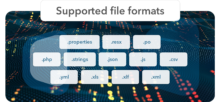
Continuous software localization solutions
Release polished products in any market with continuous software localization services
Whether SaaS, apps or enterprise platforms, you can rely on our agile localization experts for on-time, quality translations.
Focus on what you do best
With deep software localization knowledge and best practices, our tech-enabled team will sync the process with your development cycles for maximum efficiency. Whether daily string translations, biweekly agile sprints or semi-annual waterfall releases, we make the process easy for you.
Rely on the industry choice
With so many moving parts, how you approach localizing software can make or break the global success of your product. We are equipped to take on the most complicated, high-stakes software releases under the tightest deadlines. Enterprise technology leaders from Meta, IBM, Lyft, AppDirect, and Palantir will tell you the same thing: Acclaro is the industry choice for continuous software localization services.

Software localization services
Collaborate with a team of software localization experts
It takes a detail-oriented, highly collaborative team to bring together the processes of translation and product development. Your dedicated project manager is an attentive guide from software localization kick-off through international product launch and maintenance.
Ensure a great user experience
Native-speaking, in-country translators and editors curated specifically for your subject matter are an extension of your team. Trained on your product and skilled in software and mobile app localization, these linguists as well as localization engineers help ensure a great local user experience.
Support in common file formats
To support your agile string translations, we work with all common file formats, including .properties, .json, xml, and more.

Software localization insights
Succeed across cultures in 125+ languages and 300+ language pairs
View allLeading brands rely on Acclaro




















Power your strategic growth
Go beyond tactical localization with tailored, strategic solutions that resonate locally and drive growth globally.
Get started






